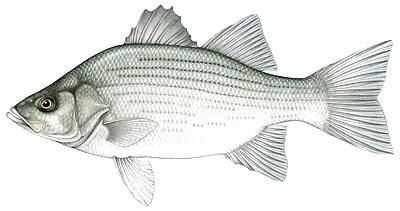White Bass

Species Details
Morone Chrysops
Moronidae
Perciformes
Lake, River
1 - 5 lbs.
10" - 18"
White Bass (Morone chrysops) Fish Description
Also known as Sand Bass or Silver Bass, the White Bass is a member of the Moronidae or Bass Family.
As its name suggests, the White Bass is primarily colored silvery-white to pale green. Its back is darker, but its belly and sides are white. The White Bass has narrow and dark stripes along the sides of its belly. It has rough scales that are distinctively big; it possesses two dorsal fins. Its body is compressed laterally.
To identify White Bass, look for a lateral line with around 51 to 60 scales. This species also has dorsal fins numbering 12 to 14; anal fin rays, 11 to 14; pectoral fin ray, 15 to 17; and 20 to 25 gill rakers. Another characteristic of the White Bass is its prominent tooth patch near the tip of its tongue.
Diet and Size
As a carnivorous feeder, the White Bass has at least four favorite major diet options: the leptodora, daphnia, cyclopoid copepods, and calanoid copepods. White Bass are visual feeders who will readily bite any live bait especially minnows and worms.
The White Bass can measure up to 10 to 12 inches in length; some are even recorded to have reached 18 inches. Generally, they weigh up to 7 pounds.
Interesting Facts About the White Bass
- The White Bass is Oklahoma’s state fish.
- The White Bass has gained acclaim as a significant sport fish in Manitoba since it was introduced there in the 1960s.
- The White Bass has a “fake” spinous ray. It also has a homocercal tail.
- Female White Bass lay around 240,000 to 930,000 eggs; they spawn from mid-March to late May.
- One unusual mating ritual among the White Bass is how males bump against the female’s abdomen. After that, the female goes near the surface to begin spinning and releasing eggs.
White Bass — Fishing Techniques
The White Bass is very popular among recreational anglers; in fact, this is the fifth most favored species among licensed fishers from Texas.
Once you sight a school of White Bass, make sure to use spinners or spoons along the water surface to entice them. One other common method of luring them is by using bottom fishing at night; you can also utilize live bait.
You can use small jigs as artificial lures; a 1/8 ounce marabou jig should do the trick. For best results, use jigs that are black or white. If you go for soft plastic lures, try the tube bait, or a small jig head with a curly tail grub. One other lure you can utilize is a small jig packed with soft plastic swimbaits; you can have either the 1/8 or ¼ ounce jigs.
Be careful because White Bass are known to be aggressive fighters. However, this struggle may be worth it because of its exceptional taste.
Note that every state may have some regulations as to the size, length, and other factors related to capturing this fish.
White Bass Habitat and Distribution
The White Bass are fairly distributed in the US, especially in the Midwest. They are plenty around Lake Erie and Pennsylvania. Most of the White Bass population are native to Lake Poinsett, Detroit River, Arkansas River, the Great Lakes, and the Red River drainage. They also inhabit the lakes in Winnebago, Wisconsin and the rivers in Mississippi.
This species generally inhabits big rivers and shallow rivers, reservoirs, streams, and creeks. They are often found upstream where there are high densities.






